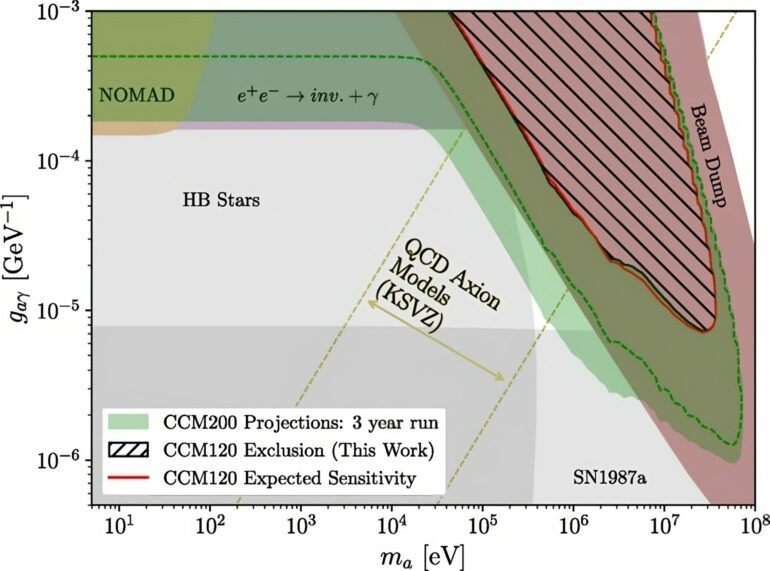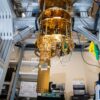Since axions were first predicted by theory nearly half a century ago, researchers have hunted for proof of the elusive particle, which may exist outside the visible universe, in the dark sector. But how does one find particles that can’t be seen?
The first physics results from the Coherent CAPTAIN-Mills experiment at Los Alamos —just described in a publication in the journal Physical Review D—suggest that liquid-argon, accelerator-based experimentation, designed initially to look for similarly hypothetical particles such as sterile neutrinos, may also be an ideal set-up for seeking out stealthy axions.
“The confirmation of dark sector particles would have a profound impact on the understanding of the Standard Model of particle physics, as well as the origin and evolution of the universe,” said physicist Richard Van de Water. “A big focus of the physics community is exploring ways to detect and confirm these particles. The Coherent CAPTAIN-Mills experiment couples existing predictions of dark matter particles such as axions with high-intensity particle accelerators capable of producing this hard-to-find dark matter.”
Demystifying the dark sector
Physics theory suggests that only 5% of the universe is made up of visible matter—atoms that form things we can see, touch and feel—and that the remaining 95% is the combination of matter and energy known as the dark sector. Axions, sterile neutrinos and others may explain and account for all or part of that missing energy density.
The existence of axions could also resolve a longstanding problem in the Standard Model, which outlines the known behavior of the subatomic world. Sometimes referred to as “fossils” of the universe, speculated to originate just a second after the Big Bang, axions could also tell us much about the founding moments of the universe.
The Coherent CAPTAIN-Mills experiment was one of several projects to receive Department of Energy funding for dark sector research in 2019, along with substantial funding from the Laboratory Directed Research and Development program at Los Alamos. A prototype detector dubbed the CCM120 was built and run during the 2019 Los Alamos Neutron Science Center (LANSCE) beam cycle. The Physical Review D publication describes results from the CCM120’s initial engineering run.
“Based on the first run of CAPTAIN-Mills research, the experiment has demonstrated the capability to execute the search for axions,” said Bill Louis, also a physicist on the project at Los Alamos. “We’re realizing that the energy regime provided by the proton beam at LANSCE and the liquid argon detector design offers an unexplored paradigm for axion-like particle research.”
Experiment design
Stationed in the Lujan Center adjacent to LANSCE, the Coherent CAPTAIN-Mills experiment is a 10-ton, supercooled, liquid argon detector. (CAPTAIN stands for Cryogenic Apparatus for Precision Tests of Argon Reactions with Neutrinos.)
High-intensity, 800-megaelectron volt protons generated by the LANSCE accelerator hit a tungsten target in the Lujan Center, then traverse 23 meters through extensive steel and concrete shielding to the detector to interact in the liquid argon.
The prototype detector’s interior walls are lined with 120, eight-inch, sensitive photomultiplier tubes (hence the CCM120 moniker) that detect light flashes—single photons—that result when a regular or dark sector particle jostles an atom in the tank of liquid argon.
A special material coating on the interior walls converts the argon light emission into visible light that can be detected by the photo-multiplier tubes. Fast timing of the detector and beam helps remove the effects of background particles such as beam neutrons, cosmic rays and gamma-rays from radioactive decays.
Pieces of the puzzle
Axions are of great interest because they are “highly motivated”; that is, their existence is strongly implied in theories beyond the Standard Model. Developed over more than 70 years, the Standard Model explains three of the four known fundamental forces—electromagnetism, the weak nuclear force and the strong nuclear force—that govern the behavior of atoms, the building blocks of matter. (The fourth force, gravity, is explained by Einsteinian relativity.) But the model isn’t necessarily complete.
An unresolved problem in Standard Model physics is known as the “strong CP problem,” with “CP” meaning charge-parity symmetry. Essentially, particles and their antiparticle counterparts are acted upon similarly by the laws of physics. Nothing in Standard Model physics mandates that behavior, though, so physicists should see at least occasional violations of that symmetry.
In weak-force interactions, charge-parity symmetry violations do occur. But no similar violations have been observed in strong-force interactions. That puzzling absence of theoretically possible behavior represents a problem for Standard Model theory. What prevents violations of charge-parity symmetry from occurring in strong-force interactions?
Abundant, nearly weightless and electrically neutral, axions may be an important part of the puzzle. The axion earned its moniker in 1978, so-coined by physicist Frank Wilczek after a brand of laundry detergent because such a particle could “clean up” the strong CP problem. Physicists speculate that they are components of a dark matter force that preserves charge-parity symmetry, and that they may couple, or interact with, photons and electrons.
Next steps
If axions do exist, finding them might be a matter of devising the right experimental set-up.
“As a result of this initial run with our CCM120 detector, we have a much better understanding of the signatures connected with axion-like particles coupled to photons and to electrons as they move through liquid argon,” said Louis. “These data give us the insight to upgrade the detector to be more sensitive by an order of magnitude.”
More information:
A. A. Aguilar-Arevalo et al, Prospects for detecting axionlike particles at the Coherent CAPTAIN-Mills experiment, Physical Review D (2023). DOI: 10.1103/PhysRevD.107.095036
Provided by
Los Alamos National Laboratory
Citation:
The hunt for elusive axion particles: Experiments suggest better methods for exploring the dark sector (2023, June 7)



